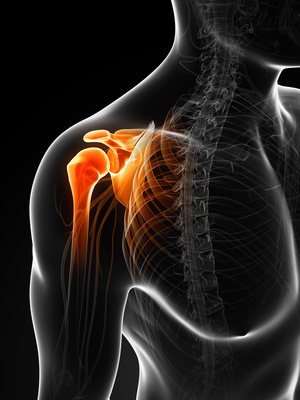 Frozen shoulder, also known as adhesive capsulitis, is a condition that restricts mobility in the affected arm. A healthy shoulder joint has a greater range of motion than any other joint in the human body. In this condition, the capsule around the shoulder joint becomes inflamed, scarred, thickened, or contracted, forming scar tissue and causing stiffness in the shoulder joint.
Frozen shoulder, also known as adhesive capsulitis, is a condition that restricts mobility in the affected arm. A healthy shoulder joint has a greater range of motion than any other joint in the human body. In this condition, the capsule around the shoulder joint becomes inflamed, scarred, thickened, or contracted, forming scar tissue and causing stiffness in the shoulder joint.
Even though trauma can sometimes lead to frozen shoulder, the cause is largely unknown.
Known causes or risk factors for frozen shoulder include:
- Age and Gender – Frozen shoulder typically occurs in patients who are 40-60 years of age and for reasons still unknown, is twice as likely to occur in women than men.
- Diabetes – Endocrine disorders (diabetes and thyroid issues) are a leading cause of frozen shoulder.
- Shoulder surgery – Patients who undergo shoulder, chest, or breast surgery are at risk for developing frozen shoulder. This is especially true for patients whose recovery process includes long periods of immobilizing the shoulder joint.
- Systemic diseases – Conditions like heart disease and Parkinson’s disease have been linked to frozen shoulder.
Typical symptoms of frozen shoulder are:
- Dull, aching shoulder pain
- The inability to move your shoulder in a wide range of motion
- Difficulty with common everyday activities such as getting dressed or putting on glasses.
- Pain when sleeping or otherwise applying pressure to the affected shoulder.
If you suspect frozen shoulder, schedule a visit with your medical practitioner. A physical examination and x-rays may be warranted to determine the extent of involvement.
The Stages of Frozen Shoulder
There are three stages of frozen shoulder.
 Stage 1: Usually lasts between 6-12 weeks, is by far the most painful, but also the shortest stage of frozen shoulder. While you will notice restricted motion in this stage, your shoulder won’t be nearly as ‘stiff’ as during the second stage.
Stage 1: Usually lasts between 6-12 weeks, is by far the most painful, but also the shortest stage of frozen shoulder. While you will notice restricted motion in this stage, your shoulder won’t be nearly as ‘stiff’ as during the second stage.
Stage 2: The “Frozen Stage”: Over the next several weeks (or months), pain will subside, but don’t be alarmed if the stiffness increases, and you notice a loss of motion. At this stage, the right kind of care (especially the kind we provide) is critically important to prevent long term damage.
Stage 3: The “Thawing Stage”: In this final stage, range of motion steadily improves. While the thawing stage steadily brings relief, it can take many months of recovery to return to a degree of normalcy.
A Shoulder To Lean On
Stretching exercises represent a critical component in the treatment of frozen shoulder, which is where we help every step of the way.
Stretching is important for 2 reasons
- It helps increase shoulder motion, and
- It can minimize the loss of muscle tissue in the affected arm.
Gradual, progressive stretching within the limits of pain is the best strategy as pain reduces.
Some examples that your physical therapist might suggest include:
- Cane exercises: Hold a straight cane or long umbrella in front of you at hip height. Slowly raise the cane above your head as high as you can. Perform as directed by your therapist.
- Pulley exercises: Using a pulley system over a door or a wall-mounted hook, pull with the uninjured hand to bring the injured arm up and over your head to stretch the shoulder. Be sure to stay within the limits of pain. Perform as prescribed by your therapist.
Our highly experienced staff can help you find the right stretches for every stage of injury. We will create a personalized program designed to help you recover quickly. Don’t let frozen shoulder slow you down.
We welcome the opportunity to work with you as a team to overcome frozen shoulder and facilitate your road to recovery.